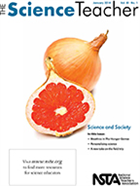Science and society
By Mary Bigelow
Posted on 2014-01-09

As the editor notes: “All students will need to make ethical decisions about complex socio-scientific issues that arise as a consequence of new science and technology.” So how does this translate to the classroom? The featured articles in this month’s issue describe several classroom-implemented lessons and units that go beyond the presentation of content to including the processes of analysis and argumentation—helping students exmine issues and develop their ability to make informed decisions.
Using popular fiction as a context for evaluating the effects of genetic engineering is the focus of Bioethics in the Hunger Games. The authors provide connections between the book and science concepts. They include assessment prompts aligned with Bloom’s Taxonomy and a chart that could be shared with students on determining the credibility of their sources. The culminating activity is round table format for presenting student arguments. There are suggestions for setting up and using a round table presentation (including a rubric). [SciLinks: Genetic Engineering]
Justifying a position on socio-scientific topics through argumentation is also the featured process in Beyond “My Opinion Versus Yours.” The article includes a strategy called the Silent Debate, in which pairs of students support their arguments by writing on a piece of paper that they pass back and forth. I can see how this idea prevents shouting matches and allows all students to participate, not just the more vocal ones. [SciLinks: Bioethics]
This month’s Green Room column has suggestions for going Back to Ecological Basics. The author’s big picture: To function, all organisms and ecosystems rely on a constant cycling of matter. How can human behaviors affect these cycles? [SciLinks: Water Cycle, Carbon Cycle, Nitrogen Cycle, Phosphorous Cycle]
I was intrigued by the subtitle of A New Take on the Field Trip: A low-tech, inquiry-based virtual field experience. The author describes a process she used to create a virtual field experience that could be replicated for any topic and subject area. She provides a step-by-step procedures for planning, constructing, and sharing the experience. Although her examples feature on earth science, the process could be applied to any content area (a trip inside the cell?). The extension is also interesting: Having students use the process to create experiences. This could be an authentic assessment opportunity. In this month’s Connections the author shares a sample virtual field experience and more suggestions. [Use SciLinks to find graphics, maps, simulations on a variety of topics]
Perhaps students could take a virtual trip to explore Micro World. The article describes a study of microfossils and pollen, and I learned a new word—palynology, the study of ancient or modern pollen from 5 to 500 microns. [SciLinks: Foraminifera, Fossil Pollen]
Personalizing Science includes four lessons and five strategies for engaging students in socio-scientific issues. The author includes a matrix showing how the five strategies mesh with lessons on food choices (nutrition), heart transplants (circulatory system), herbal supplements (organic compounds), and Huntington’s Disease (molecular genetics) and were implemented in core science courses. [SciLinks: Nutrition, Circulatory System, Organic Compounds, Genetics]
Disclaimer: The views expressed in this blog post are those of the author(s) and do not necessarily reflect the official position of the National Science Teaching Association (NSTA).


